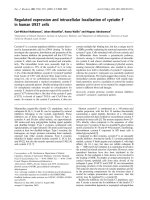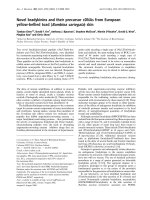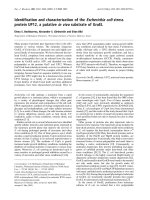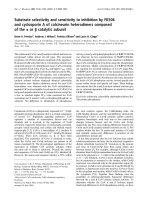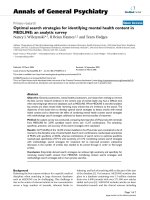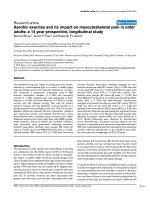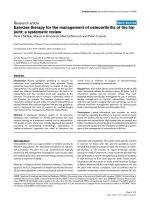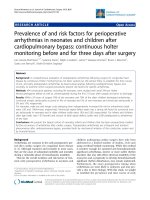Báo cáo y học: " Perceived barriers and facilitators to mental health help-seeking in young people: a systematic review" potx
Bạn đang xem bản rút gọn của tài liệu. Xem và tải ngay bản đầy đủ của tài liệu tại đây (296.15 KB, 9 trang )
RESEARC H ARTIC LE Open Access
Perceived barriers and facilitators to mental
health help-seeking in young people: a
systematic review
Amelia Gulliver
*
, Kathleen M Griffiths, Helen Christensen
Abstract
Background: Adolescents and young adults frequently experience mental disorders, yet tend not to seek help.
This systematic review aims to summarise reported barrier s and facilitators of help-seeking in young people using
both qualitative research from surveys, focus groups, and interviews and quantitative data from published surveys.
It extends previous reviews through its systematic research methodology and by the inclusion of published studies
describing what young people themselves perceive are the barriers and facilitators to help-seeking for common
mental health problems.
Methods: Twenty two published studies of perceived barriers or facilitators in adolescents or young adults were
identified through searches of PubMed, PsycInfo, and the Cochrane database. A thematic analysis was undertaken
on the results reported in the qualitative literature and quantitative literature.
Results: Fifteen qualitative and seven quantitative studies were identified. Young people perceived stigma and
embarrassment, problems recognising symptoms (poor mental health literacy), and a preference for self-reliance as
the most important barriers to help-seeking. Facilitators were compa ratively under-researched. However, there was
evidence that young people perceived positive past experiences, and social support and encouragement from
others as aids to the help-seeking process.
Conclusions: Strategies for improving help-seeking by adolescents and young adults should focus on improving
mental health literacy, reducing stigma, and taking into account the desire of young people for self-reliance.
Background
The burden and prevalence of mental disorders
Depression and anxi ety are highly prevalent mental dis-
orders with estimates indicating they affect up to almost
one fifth of the population in high income countries
worldwide [1-3]. Prevalence of mental disorders is great-
est among younger people aged 16-24 years [4] than at
any other stage of the lifespan. They are also common
in childhood and adolescence with 14% of those aged
between 4 and 17 years affected [5]. This high suscept-
ibility in adolescents and y oung adults to developing a
mental disorder is coupled with a strong reluctance to
seek professional help [6].
Reluctance to seek help
Studies have found that approximately 18 to 34% of
young people with high levels of depression or anxiety
symptoms seek professional help. For example, a school-
based study of 12 to 17 year old German adolescents
reported that only 18.2% of those with diagnosable anxi-
etydisorders,and23%ofthosewithdepressivedisor-
ders had ever used mental health services [7]. Similarly,
a large study of over 11,000 Norwegian adolescents in
school aged 15 to 16 years found that only 34% of those
with high levels of depression and anxiety symptoms
had sought professional help in the previous year [8].
According to an Australian national m ental health s ur-
vey of young people only 25% of children aged 4 to 17
years with a diagnosable mental disorder had used any
health services in the 6 months prior to the survey [5].
This reluctance to seek help is not limited to children
and adolescents. Adults of all ages often d o not seek
* Correspondence:
Centre for Mental Health Research, The Australian National University,
Canberra, Australia
Gulliver et al. BMC Psychiatry 2010, 10:113
/>© 2010 Gulliver et al; licensee BioMed Central Ltd. This is an O pen Access article distributed under the terms of the Creative Commons
Attribution License ( which permits unrestricted use, distribution, and reproduction in
any medium, provided the original work is properly cited.
help for a mental illness [9], with only 35% of those
surveyed with a common mental disorder seeking help
during the previous year [4].
Proposed reasons for not seeking help
Many reasons have been proposed to explain why
adults in the general population do not seek profes-
sional help for common mental disorders. These
include negative attitudes towards seeking help gener-
ally [10], as well as concerns about cost, transportation
or inconvenience, confidentiality, other people finding
out, feeling like they can handle the problem on their
own, and the belief that the treatment will not help
[11]. Similar concerns have been found in a rural popu-
lation, with the addition of worry that that the care will
be unavailable when needed, about being treated
unkindly, and not knowing where to go [12]. Conver-
sely, facilitators h ave been proposed to include prior
treatment, higher education, and greater mental disor-
der episode length [13], and the influence of intimate
partners and general practitioners [14].
Likewise, research has sought to explain the reluctance
of young people and adolescents to seek professional
help when it is necessary. Friends and family are often
the preferred sources of help over health professionals
[6,15]. In two reviews of help-seeking studies , Rickwood
and her collaborators concluded that a high reliance on
self to solve problems, a lack of emotional competence,
and negative attitudes about seeking professional help
were barriers to help-seeking [6,16]. Conversely, the
authors identified a number of possible facilitators of
help-seeking. These included emotional competence,
knowledge, positive attitudes towards seeking profes-
sional help, social encouragement, and the availability of
established and trusted relationships with professionals
such as general practitioners [6]. These reviews were
based around a model of help-seeking [16] in which
seeking professional help is conceptualised as a multi-
step process beginning with the individual’ s develop-
ment of an awareness of the problem, followed by the
expression of the problem and a need for help to others,
the identification of appropriate of sources of help for
the individual to access, and finally, the willingness of
the individual to actually seek out and disclose to
potential sources of help. In another review, Barker
and colleagues [17] differentiated between structural
and personal determinants of help-seeking. They main-
tained that individual factors, such as personal beliefs,
internalised gender norms, coping skills, self-efficacy,
and perceived stigma interact with structural factors
including the national health system, accessibility and
affordability of services, and social support. However,
none of these reviews were systematic syntheses of
the available quantitative and qualitative literature.
Moreover, they focused primarily on quantitative
cross-sectional correlational studies (e.g., primarily sur-
vey studies which measured the association between a
measured barrier such as low emotional competence
and the young person’ sintentionstoseekhelp[18])
and largely overlooked the qualitative research. The
qualitative research in particular may provide addi-
tional and different information about the reasons that
young people do not seek help to structured survey
questions. Moreover, currently no review has systema-
tically identified and synthe sised the literature which
asks young people themselve s what they perceive are
the barriers and facilitators to help-seeking. This sys-
tematic review seeks to address t his gap.
Aims and scope of this study
This study is a systematic review of both the qualitative
and the quantitative literature on the perceived barriers
and facilitators to help-seeking f or mental health pro-
blems in adolescents and young adults. In this paper
‘ adolescents’ refers to those age d between 12 and 17
years and ‘young adults’ to those aged 18 to 25 years
[19]. It focuses on help- seeking for the common mental
health problems of depression, anxiety and general emo-
tional distress.
Methods
Databases & Search methodology
Three databases (PubMed, PsycINFO, and Cochrane)
were searched in September and October 2009 using
the search terms presented in additional file 1: Search
terms. These terms aimed to represent the primary con-
cepts of ‘ help-seeking’ , ‘mental health’ ,and‘ barriers’ or
‘facilitators’. Keywords were generated for each of these
concepts by examining the terminology used in review
papers in the help-seeking literature and a thesaurus to
locate synonyms. In addition, the keywords were com-
bined with standar d MeSH terms from the PubMed and
Cochrane databases and Subject Headings for the Psy-
cINFO database.
Study Selection
Figure 1 presents the flow chart for the selection of the
included studies. The initial database search retu rned
3637 published English-language abstracts after remov-
ing duplicates. One of the researchers ( AG) then
screened the abstracts and excluded studies that did not
address barriers or facilitators to help-seeking for a
mental health problem. This resulted in 260 potentially
relevant studies. An additional 32 studies were located
through hand-searching the reference lists of reviews
and key papers found through the systematic search and
whichwereconsideredlikelytosatisfytheinclusion
criteria.
Gulliver et al. BMC Psychiatry 2010, 10:113
/>Page 2 of 9
The second stage of the study select ion pr ocess
involved examining each of t he 292 articles and exclud-
ing those which met the following exclusion criteria.
1. Participants were not explicitly asked what they
considered were barriers or facilitators to help-seeking
for mental health problems.
2. Study participants were neither adolescents nor young
adults (aged 12-25 years). This criterion was considered
met if more than 25% of the participants fell outside the 12
to 25 years age range, the sample mean age was 26 years or
more, the sample was specifically described as “adults” with
the age of the participants no further described.
3. Study was a review.
4. Study participants were not members of the general
community, or university, or school students (e.g.,
studies of groups with restricted access to a range of
help-seeking opportunities such as prisoners and mem-
bers of the military).
5. Study was focused on help-seeking on behalf of
another person (e.g., carer seeking help for a consumer,
or parent seeking help for a child).
6. Study contained no extractable data on barriers or
facilitators.
7. Study addressed a mental health condition ot her
than depression, or anxiety, or general “ mental dis-
tress” (e.g., psychosis, obsessive compulsive disorder).
Studies of pre- or post-natal depression were also
excluded.
270 studies met one or more of these criteria and
were excluded from further consideration. No studies
were excluded on the basis of research quality. A sum-
mary of the excluded studies grouped by the primary
reason for the exclusion is provided in additional file 2:
List of studies e xcluded from the review by exclusion
category. This process resu lted in a total of 22 relevant
studies [20-41] for inclusion into the review.
Records identied through database
searching
(n = 3637)
Excluded (n = 270)
121 = Does not ask about barriers or
facilitators
88 = Not for depression or anxiety
32 = Not young adults (12-25yrs)
11 = Review
11 = Not from community
5 = Parent carer
2 = Data not extractable
Records after duplicates removed
(n = 3669)
Additional records identied through
other sources
(n = 32)
Records screened
(n=3669)
Records excluded
(n = 3377)
Full-text articles
assessed for
eligibility
(n = 292)
Studies included in
qualitative synthesis
(n = 22)
Figure 1 Study selection flow diagram.
Gulliver et al. BMC Psychiatry 2010, 10:113
/>Page 3 of 9
Coding of Studies
Each of the 22 included studies was coded using a
pre-formulated rating sheet according to the following
characteristics: Author name, year published, country
(location of study), age of participants (age range or
mean), population description, whether the study parti-
cipants were selected regardless of mental health status
or risk profile (universal) or not, sample size (for target
variable), gender (male, female, both), setting (e.g., high
school, community, university), research type (qualita-
tive, quantitative), specified barriers to help-seeking
(description of barrier themes or items as listed in the
study), and specified facilitators of help-seeking (descrip-
tion of facilitator themes or items as listed by the study).
Analysis strategy
Standard methods for thematic analysis [42] were con-
ducted on participant reported barriers and facilitators
in the qualitative studies. Barriers and facilitators
reported in the quantitative studies were tabulated and
top rated themes extracted.
Results
1. Study characteristics
The characteristics of each of the qualitative and quanti-
tative studies of the perceived barriers and facilitators o f
help-seeking in young people are detailed in additio nal
file 3: Qualitative studies included in the review; and
additional file 4: Quantitative studies included in the
review. The following section provides an overview of
these characteristics including the year and location of
the study, the methodologies employed, and the charac-
teristics of the study participants.
Year and location of studies
The studies were published between 1990 and 2008 with
most conducted in the Austral ia (n = 10), or the United
States (n = 9). A further tw o studies were undertaken in
the United Kingdom, and one in China.
Methodologies employed
The majority of studies were conducted using qualitative
methods (n = 15), the remainder being quantitativ e stu-
dies. All seven quantitative studies used a survey method
to collect data. However, the methodology employed in
the 15 qualitative studies varied: seven involved inter-
views, four used focus groups, three used a survey
method to collect data, and one employed both focus
groups and interviews.
Sample and participant characteristics
Sample size The number of participants in the studies
varied markedly from 3 to 3746. The majority of the
qualitative studies (n = 12 of 15) employed between 3
and 52 participants, and a further three involved
between 326 and 3746 participants. Sample sizes for the
seven quantitative studies ranged from 71 to 294.
Participant age Data reported on the ag e of partici-
pants varied. Many studies provided an age range in
years (11-17 to 18-31+ ) or the mean age of participants
(15.4-21.2). However, some studies r eported the grade
of the participants only, and these ranged from grades 7
to 12.
Gender Most studies included both males an d females
(n = 19). However, two focused exclusively on males
and one on females only.
Settings and target groups Half of t he included studies
(n = 11) were conducted in a high school setting. Of
these, one examined Caucasian male students, and one,
rural students. Five studies took place in universities. Of
these, two out of five examined medical students specifi-
cally, and one recruited rural psychology undergradu-
ates. Five studies were undertaken in a community
setting, of which one examined at-risk African American
male adolescents, and another investigated rural adoles-
cents. Finally, one study was undertaken in both a high
school and a community setting [41]. Overall, three of
the studies involved a rural population.
Mental health status of participants Most studies
(n = 14) were conducted with samples not selected on
the basis of participant mental health status. However,
three studies focused on participants w ith self reported
depression, another two focused on self-reported
depression and/or anxiety, and the final three included
participants with general ‘ mental distress’ , ‘amental
health issue’ ,ora‘ health related problem’,thelatter
from which only data for participants experiencing
self-reported depression w ere included in the present
review [26].
2. Perceived barriers and facilitators
Analysis of qualitative studies
Fifteen of the qualitative studies identified participant
perceived barriers and facilitators to help-seeking for
mental health problems. Two [30,33] studies were
excluded from this formal analysis as rather than exam-
ining help-seeking more generally, they only addressed
characteristics of school-based personnel that may aid
or deter help-seeking. A meta-thematic analysis of the
remaining 13 papers was conducted by collating and
coding data into themes developed from terminology
use d by the reviewed literature. Topics specified as bar-
riers or facilitators to help-seeking in the papers were
coded respectively under thirteen different barrier and
seven facilitator themes. For the detailed findings of this
thematic analysis see additional file 5: Thematic analysis
of qualitative studies.
(a). Barrier themes: Table 1 summarises the key bar-
rier themes emerging from the analysis in order of fre-
quency of studies in which the the me was addressed.
The most frequently mentioned barrier was stigma
Gulliver et al. BMC Psychiatry 2010, 10:113
/>Page 4 of 9
which was reported in over three-quarters of the studies.
In addition, almost half of the studies cited issues
related to confidentiality and tr ust. Over one-third of
studies referred to difficulties with identifying symp-
toms, concern ab out the characteristics of the provider,
and relia nce on self a s perceived ba rriers to help-
seeking.
(b). Facilitator themes: Few of the qualitative studies
addressed the perceived facilitators of mental health
help-seeking. Accordingly, only a limited analysis was
possible. Table 2 details the eight facilitator themes
raised in the three studies included in this analysis. Posi-
tive past experiences were mentioned by all papers
examining facilitators, and it was also the theme for
which the greatest number of individual facilitators was
reported.
Analysis of quantitative studies
None of the seven quantitative studies addressed facilita-
tors. Each of these studies used a survey method to elicit
respondent views about relevant barr iers (i.e., responses
to barrier scales, endorsing barriers from a list, and
rating the relative importance of barriers).
(a). Barrier themes: The list of potential barriers rated
by participants in the quanti tative studies varied across
studies. The top rated barriers (i.e., those endorsed by
the g reatest percentage of respondents or achieving the
highest mean rating) are detailed in Table 3. The most
commonly endorsed included stigma and discomfort dis-
cussing mental health problems, a p reference for relying
on self,andafailure to perceive a need for help.Other
top rated barriers from the quantitative studies were
believing that no one could help [26], not liking t o
disclose personal matters to a stranger [37], and not
feeling comfortable talking to a general practitioner
whom the young person did not know [38].
Discussion
The present review identified a range of perceived bar-
riers and facilitators to help-seeking. However, it is clear
from the present systematic review that there is a pau-
city of high quality research in the area, little emphasis
on identifying facilitators, and a focus on qualitative
rather than quantitative data collection. T he following
discussion considers the most prominent barrier and
facilitator themes from the systematic review, defined as
those with at least five or more barriers or facilitators in
the qualitative thematic analysis, and places them in the
context of previous reviews and r elated studies in the
literature.
Prominent barrier themes
Public, perceived and self-stigmatising attitudes to mental
illness
Inthepresentstudystigmaandembarrassmentabout
seeking help emerged in both the qualitative and quan-
titative stud ies as the most prominent b arrier to
help-seeking for mental health problems. This finding is
consistent with conclusions from previous reviews of
help-seeking in this age group [16,17]. It is of interest
that all three studies focusing on rural populations
[20,23,28] mentioned a high rate of barriers related to
stigma, which is consistent with a previous finding that
perceived stigma ma y affect help-seeking more in rural
than urban residing adults [43]. Another stu dy of com-
munity-based young people [31] also reported many
stigma-related barriers to help-seeking from specific
sources (e.g., doctor, counsellor etc.). Most of these
were concerns about what others, including the source
of help itself, might think of them if they were to seek
help.
Table 1 Key barrier themes and number of studies
(n = 13) in which theme addressed
# Barrier theme Number
of studies
1 Public, perceived and self-stigmatising attitudes
to mental illness
10
2 Confidentiality and trust 6
3 Difficulty identifying the symptoms of mental
illness
5
4 Concern about the characteristics of the provider 5
5 Reliance on self, do not want help 5
6 Knowledge about mental health services 4
7 Fear or stress about the act of help-seeking or
the source of help itself
4
8 Lack of accessibility, e.g., time, transport, cost 4
9 Difficulty or an unwillingness to express emotion 3
10 Do not want to burden someone else 2
11 Prefer other sources of help (e.g., family, friends) 2
12 Worry about effect on career 1
13 Others not recognising the need for help or not
having the skills to cope
1
Table 2 Key facilitator themes and number of studies
(n = 3) in which theme addressed
# Facilitator theme Number of studies
1 Positive past experiences with help-seeking 3
2 Social support or encouragement from others 2
3 Confidentiality and trust in the provider 2
4 Positive relationships with service staff 2
5 Education and awareness 1
6 Perceiving the problem as serious 1
7 Ease of expressing emotion and openness 1
8 Positive attitudes towards seeking help 1
Gulliver et al. BMC Psychiatry 2010, 10:113
/>Page 5 of 9
Confidentiality and trust
A major concern for many of the study participants was
confidentiality and trust with respect to the potential
source of help. This concern has been identified as a
barrier in previous reviews [6,16] which report that
young people show greater help-seeking intentions
towards trusted sources. C oncern about confidentiality
andtrustmayalsorelatetostigma,whereafearofa
breach in confidentiality stems from the fear of stigma
and embarrassment should peers and family find out
that the young person had sought help.
Difficulty identifying the symptoms of mental illness
A lack of insight into or understanding of symptoms has
been discussed previously in the contex t of help seeking
in cross-sectional correlational studies [15] and reviews
[16]. One st udy [21] of young people with mental dis-
tress reported that participants were aware of their
distress, but continuously altered the meaning they
attached to this distress, and in particular whether or
notitwas“ normal” in order to accommodate higher
levels of distress and avoid seeking help.
Lack of accessibility
Lack of accessibility (e.g., time, transp ort, cost) was a
prominent barrier particularly in the studies of rural
populations, a finding which is consistent with previous
research on adults in rural areas [12]. In rural settings
where there is a paucity of mental health professionals,
young people may find it difficult to source close by and
available help.
Self-reliance
Both the qualitative and quantitative research in the pre-
sent study indicated that adolescents and young a dults
prefer to rely on themselves rather than to seek external
help for their problems. Again, this common barrier to
help-seeki ng has also been rep orted in previous reviews
of cross-sectional studies [6]. In addition, previous
research suggests t hat adolescent preferences for self-
reliance during difficult times, extends to a preference
for self-help as a treatmen t for mental health difficulties
[44].
Concern about characteristics of provider
Some of the studies in the review found that the charac-
terist ics of the potential provider of help (e.g., psycholo-
gist, general practitioners etc.) could be deterrents to
seeking help. This included features such as race, the
ability of the provider to pr ovide help, their credibility,
and whether they were known to the young person.
Though they were not incorporated into the thematic
analysis, two studies [30,33] reported the qualities of
potential providers in schools that young people per-
ceived as barriers to help-seeking. These were active
negativity ("rude and smart aleck”), breach of confidenti-
ality ("not enough privacy in school”), dual roles ("hard
to talk to somebody when you think of them as an
enforcer of the school rules”), judgmental attitude or
tendency to show favouritism ("some adults don’tsee
both sides”), unhelpful responses ("they blow it out of
proportion-exaggerate”), being out of touch with adoles-
cents ("they don ’t know about gangs and drugs”), psy-
chologically inaccessible ("never assure you that you can
come and talk to them”), and too busy ("they have too
many kids to deal with”). These two studies also empha-
sise that young people place importance on the charac-
teristics of the person potentially providing the help.
Knowledge about mental health services
Young peoples’ lack of knowledge about mental health
services was also a perceived barrier to help-seeking, a
finding which is consi stent with prior reviews [6,16,17].
In particular, study participants did not consider a
general practitioner an appropriate source of h elp for
mental distress. This has been found previously in a
Table 3 Top rated barriers by quantitative studies (n = 7)
Author Top rated barriers
Sheffield
(2004) [35]
School counsellor
1. Prefer to handle myself (45%) (self-reliance)
2. Don’t think they can help (27%) (no one can help)
Doctor
1. Too expensive (25%) (cost)
2. Prefer to handle myself (23%) (self-reliance)
Psychologist/Psychiatrist
1. Too expensive (50%) (cost)
2. Don’t know where to find (28%) (knowledge)
Dubow (1990)
[26]
1. I felt that no person or helping service could help
(55%) (no one can help)
2. The problem was too personal to tell anyone
(53%) (stigma/comfort)
West
(1991) [37]
1. I do not like to tell a stranger about personal
things (29.4%) (stigma/comfort)
2. I am afraid counsellor will pass information about
me to other people (18.3%) (confidentiality)
Kuhl, (1997) [32] 1. If I had a problem I would solve it by myself (3.87)
(self-reliance)
2. I think I should work out my own problems (3.79)
(self-reliance)
Wilson
(2008) [38]
1. I feel comfortable talking to a GP (general
practitioner) who I don’t know (1.65) (stigma/comfort)
2. I’m not embarrassed to talk about my problems
(1.51) (stigma/comfort)
Eisenberg
(2007) [27]
1. Stress is normal in graduate school (51%)
(self-reliance)
2. Have not had any need (45%) (no perceived need)
Brimstone
(2007) [24]
1. Worries about either knowing the doctor/counsellor
or having to have future dealings with the counsellor/
psychologist or general practitioner at university
health care centre (stigma/comfort)
2. Worries about either knowing the doctor/counsellor
or having to have future dealings with the counsellor/
psychologist or general practitioner at non-university
health care centre (stigma/comfort)
Gulliver et al. BMC Psychiatry 2010, 10:113
/>Page 6 of 9
qualitative research study using interviews to investigate
young peoples’ attitudes towards general practitioners as
a source of help [45].
Fear or stress about the act of help-seeking or source of
help itself
Many young people reported that they were fearful
about the act of seeking help, or the source of help
itself. C onsistent with thi s theme, there is evidence that
young people who have established relationships with
health professionals are more likely to seek help in t he
future [16]. Thus experience with sources of help may
reduce fears about the unknown, and encourage young
people to seek further help.
Prominent facilitator theme
Positive past experiences All three studies investigating
facilitators reported positive past experiences [34,36,40] as
a facilitator of help-seeking in their samples of high school
student s. Past experience with help-seeking may also act
as a form of knowledge or mental health literacy, a topic
deemed important in the help-seeking process [6,46].
Limitations
Several limitations to the present study need to be con-
sidered. First, the search strategy may not have captured
all of the relevant articles. The choice of database influ-
ences the coverage of potential journal papers to be
included [47]. This review employed only three data-
bases; some relevant journals may not have been
indexed by these databases. Further, the ter minology
utilised in the search strategy may not have been suffi-
ciently broad to capture all published research on bar-
riers and facilitators in young people. However, this
must be balanced against the feasibility of processing
the results of an over-inclusive search strategy. Hand-
searching of refere nce lists located some further papers
not captured in the database searches [48]. A final lim-
itation of the search strategy was that for practical
reasons o nly published literature was sourced; however,
it seems unlikely that publication status would be a sub-
stantial source of bias in the current context.
Another limitation is that only o ne researcher coded
the retrieved barriers and facilitators into themes and as
such the coding of themes may be biased. Qualitative
research is by its nature a subjective process. For the
purposes of transparency, t he current paper p rovides
details of the data from which the themes were
extracted in the qualitative analysis.
A further limitation of the study is that this review
utilised counts of themes and the number of studies
repo rting each theme in the qualitative research, as well
as the highest-rated barriers and facilitators in the quan-
titative research. Although such counts may reflect the
relative importance of topics we acknowledge that
this is not necessarily the case. For example, it may
overemphasise the importance of topics which were
mentioned in various different forms (e.g., self-stigma,
social stigma). However, the method provides a useful
starting point for generating futur e research and parti-
cularly for suggesting potential appropriate targets for
intervention to increase help-seeking.
Finally, it is a limitation that this study addresses only
those perceived barriers and facilitators to help-seeking
reported by young people given that the y may not be
aware of all the potentially influential factors.
Conclusions
Young people perceive a number of barriers to help-
seeking for mental health problems. These include
stigm a and embarrassment, problems recognising symp-
tom s (poor mental health literacy), and a preference for
self-reliance. These were prominent themes in both the
qualitative and quantitative literature. Less is known
about those factors which young people believe facilitate
help-seeking. However, there is some evidence that posi-
tive past experi ences, which may increase mental health
literacy, as well as social support and encouragement
from others, which may reduce the stigma of help-seeking,
are facilitators of help-seeki ng in this age group. The
findings suggest a number of ways forward. First, strate-
gies for improving mental health among young people
need to address the young person’s desire for self-reli-
ance. One potential approach involves the provision of
evidence-based self-help material. A second involves pro-
viding a program to increase the young person’s mental
health literacy, and in particular to increase their knowl-
edge of their own symptoms. A final approach involves
the provision of programs to young people that are
designed to reduce the stigma associated with mental
illness and mental health help-seeking. Nevertheless,
barriers and facilitators may vary across the different
points of the help-seeking process, and a more sophisti-
cated investigation of these factors as they operate at
each level of the help-seeking process is required to
advance the field.
This systematic review conforms to the PRISMA state-
ment [49]. A PRISMA checklist is provided in additional
file 6: PRISMA 2009 Checklist.
Additional material
Additional file 1: Search terms.
Additional file 2: List of studies excluded from the review by
exclusion category.
Additional file 3: Qualitative studies included in the review.
Additional file 4: Quantitative studies included in the review.
Additional file 5: Thematic analysis of qualitative studies.
Additional file 6: PRISMA 2009 Checklist.
Gulliver et al. BMC Psychiatry 2010, 10:113
/>Page 7 of 9
Acknowledgements
We wish to thank Alison Parsons and Jennifer Norton for their assistance
with the early stages of coding. The study was supported by a grant from
the Australian Institute of Sport (AIS). Amelia Gulliver is supported by a joint
scholarship from the AIS, the Brain and Mind Research Institute, Orygen, and
The Australian National University without which this research could not be
possible. Professor Griffiths is supported by an NHMRC Fellowship No.
525413 and Professor Christensen by NHMRC Fellowship No. 525411.
Authors’ contributions
AG designed the study and the search criteria, developed coding checklists,
coded the papers, undertook the analyses and wrote a draft of the
manuscript. KG and HC supervised all stages of the research, and
contributed to the design and analysis of the study and edited the paper.
All authors read and approved the final manuscript.
Competing interests
The authors declare that they have no competing interests.
Received: 21 October 2010 Accepted: 30 December 2010
Published: 30 December 2010
References
1. King M, Nazareth I, Levy G, Walker C, Morris R, Weich S, Bellon-Saameno JA,
Moreno B, Svab I, Rotar D, Rifel J, Maaroos HI, Aluoja A, Kalda R,
Neeleman J, Geerlings MI, Xavier M, de Almeida MC, Correa B, Torres-
Gonzalez F: Prevalence of common mental disorders in general practice
attendees across Europe. Br J Psychiatry 2008, 192(5):362-367.
2. Kessler RC, Chiu WT, Demler O, Merikangas KR, Walters EE: Prevalence,
severity, and comorbidity of 12-month DSM-IV disorders in the National
Comorbidity Survey Replication. Arch Gen Psychiatry 2005, 62(6):617-627.
3. Australian Bureau of Statistics: 2004-05 National Health Survey: Summary
of Results.Edited by: Australian Bureau of Statistics. Canberra 2006.
4. Australian Bureau of Statistics: National Survey of Mental Health and
Wellbeing: Summary of Results. Edited by: Australian Bureau of Statistics;
Canberra 2007.
5. Sawyer MG, Arney FM, Baghurst PA, Clark JJ, Graetz BW, Kosky RJ,
Nurcombe B, Patton GC, Prior MR, Raphael B, Rey JM, Whaites LC,
Zubrick SR: The mental health of young people in Australia: key findings
from the child and adolescent component of the national survey of
mental health and well-being. Aust N Z J Psychiatry 2001, 35(6):806-814.
6. Rickwood D, Deane F, Wilson C: When and how do young people seek
professional help for mental health problems? Med J Aust 2007, 187(7
Suppl):S35-39.
7. Essau CA: Frequency and patterns of mental health services utilization
among adolescents with anxiety and depressive disorders. Depress
Anxiety 2005, 22(3):130-137.
8. Zachrisson HD, Rodje K, Mykletun A: Utilization of health services in
relation to mental health problems in adolescents: a population based
survey. BMC Public Health 2006, 6:34.
9. Bland RC, Newman SC, Orn H: Help-seeking for psychiatric disorders. Can
J Psychiatry 1997, 42(9):935-942.
10. Jang Y, Kim G, Hansen L, Chiriboga DA: Attitudes of older Korean
Americans toward mental health services. J Am Geriatr Soc 2007,
55(4):616-620.
11. Mojtabai R: Unmet need for treatment of major depression in the United
States. Psychiatric Services 2001, 60(3):297-305.
12. Fox JC, Blank M, Rovnyak VG, Barnett RY: Barriers to help seeking for
mental disorders in a rural impoverished population. Community Ment
Health J 2001, 37(5):421-436.
13. Blumenthal R, Endicott J: Barriers to seeking treatment for major
depression. Depress Anxiety 1996, 4(6):273-278.
14. Cusack J, Deane F, Wilson C, Ciarrochi J: Who influence men to go to
therapy? Reports from men attending psychological services.
International Journal for the Advancement of Counselling 2004, 26(3):271-283.
15. Rickwood D, Braithwaite V: Social-psychological factors affecting help-
seeking for emotional problems. Social science & medicine (1982) 1994,
39(4):563-572.
16. Rickwood D, Deane F, Wilson C, Ciarrochi J: Young people’s help-seeking
for mental health problems. AeJAMH (Australian e-Journal for the
Advancement of Mental Health) 2005, 4(3).
17. Barker G, Olukoya A, Aggleton P: Young people, social support and help-
seeking. International. journal of adolescent medicine and health 2005,
17(4):315-335.
18. Ciarrochi J, Wilson C, Deane F, Rickwood D: Do difficulties with emotions
inhibit help-seeking in adolescence? The role of age and emotional
competence in predicting help-seeking intentions. Counselling Psychology
Quarterly 2003, 16(2):103-120.
19. Raphael B: Promoting the mental health and wellbeing of children and
young people. Discussion paper: Key principles and directions.Edited by:
National Mental Health Working Group. Department of Health and Aged
Care, Canberra.: Commonwealth of Australia; 2000:.
20. Aisbett DL, Boyd CP, Francis KJ, Newnham K, Newnham K: Understanding
barriers to mental health service utilization for adolescents in rural
Australia. Rural Remote Health 2007, 7(1):624.
21. Biddle L, Donovan J, Sharp D, Gunnell D: Explaining non-help-seeking
amongst young adults with mental distress: a dynamic interpretive
model of illness behaviour. Sociology of health & illness 2007,
29(7):983-1002.
22. Boey KW: Help-seeking preference of college students in urban China
after the implementation of the “open-door” policy. International Journal
of Social Psychiatry 1999, 45(2):104-116.
23. Boyd C, Francis K, Aisbett D, Newnham K, Sewell J, Dawes G, Nurse S:
Australian rural adolescents’ experiences of accessing psychological help
for a mental health problem. Australian Journal of Rural Health 2007,
15(3):196-200.
24. Brimstone R, Thistlethwaite JE, Quirk F: Behaviour of medical students in
seeking mental and physical health care: exploration and comparison
with psychology students. Medical Education 2007, 41(1):74-83.
25. Chew-Graham CA, Rogers A, Yassin N: ’I wouldn’t want it on my CV or
their records’: Medical students’ experiences of help-seeking for mental
health problems. Medical Education 2003, 37(10):873-880.
26. Dubow E, Lovko K Jr, Kausch D: Demographic Differences in Adolescents’
Health Concerns and Perceptions of Helping Agents.
Journal of Clinical
Child & Adolescent Psychology 1990, 19(1):44-54.
27. Eisenberg D, Golberstein E, Gollust SE: Help-seeking and access to mental
health care in a university student population. Medical Care 2007,
45(7):594-601.
28. Francis K, Boyd C, Aisbett D, Newnham K, Newnham K: Rural adolescents’
attitudes to seeking help for mental health problems. Youth Studies
Australia 2006, 25(4):42-49.
29. Gilchrist H, Sullivan G: Barriers to help-seeking in young people:
community beliefs about youth suicide. Australian Social Work 2006,
59(1):73-85.
30. Helms JL: Barriers to Help Seeking Among 12th Graders. Journal of
Educational & Psychological Consultation 2003, 14:27-40.
31. Jorm AF, Wright A, Morgan AJ: Where to seek help for a mental disorder?
National survey of the beliefs of Australian youth and their parents. Med
J Aust 2007, 187(10):556-560.
32. Kuhl J, Jarkon-Horlick L, Morrissey R: Measuring barriers to help-seeking
behavior in adolescents. Journal of Youth and Adolescence 1997,
26(6):637-650.
33. Lindsey C, Kalafat J: Adolescents’ views of preferred helper characteristics
and barriers to seeking help from school-based adults. Journal of
Educational and Psychological Consultation 1998, 9(3):171-193.
34. Lindsey MA, Korr WS, Broitman M, Bone L, Green A, Leaf PJ: Help-seeking
behaviors and depression among African American adolescent boys. Soc
Work 2006, 51(1):49-58.
35. Sheffield JK, Fiorenza E, Sofronoff K: Adolescents’ Willingness to Seek
Psychological Help: Promoting and Preventing Factors. Journal of Youth
and Adolescence 2004, 33(6):495-507.
36. Timlin-Scalera RM, Ponterotto JG, Blumberg FC, Jackson MA: A grounded
theory study of help-seeking behaviors among White male high school
students. J Couns Psychol 2003, 50(3):339-350.
37. West J, Kayser L, Overton P, Saltmarsh R: Student perceptions that inhibit
the initiation of counseling. School Counselor 1991, 39:77-83.
38. Wilson C, Deane F, Marshall K, Dalley A: Reducing adolescents’ perceived
barriers to treatment and increasing help-seeking intentions: effects of
classroom presentations by general practitioners. Journal of Youth and
Adolescence 2008, 37(10)
:1257-1269.
39. Wilson C, Rickwood D, Deane F: Depressive symptoms and help-seeking
intentions in young people. Clinical Psychologist 2007, 11(3):98-107.
Gulliver et al. BMC Psychiatry 2010, 10:113
/>Page 8 of 9
40. Wilson CJ, Deane FP: Adolescent opinions about reducing help-seeking
barriers and increasing appropriate help engagement. Journal of
Educational & Psychological Consultation 2001, 12(4):345-364.
41. Wisdom JP, Clarke GN, Green CA: What teens want: barriers to seeking
care for depression. Administration and Policy in Mental Health and Mental
Health Services Research 2006, 33(2):133-145.
42. Liamputtong P, Ezzy D: Qualitative Research Methods Melbourne: Oxford
University Press; 2005.
43. Wrigley S, Jackson H, Judd F, Komiti A: Role of stigma and attitudes
toward help-seeking from a general practitioner for mental health
problems in a rural town. The Australian and New Zealand journal of
psychiatry 2005, 39(6):514-521.
44. Farrand P, Perry J, Lee C, Parker M: Adolescents’ preference towards self-
help: Implications for service development. Primary Care & Community
Psychiatry 2006, 11(2):73-79.
45. Biddle L, Donovan JL, Gunnell D, Sharp D: Young adults’ perceptions of
GPs as a help source for mental distress: a qualitative study. Br J Gen
Pract 2006, 56(533):924-931.
46. Kelly C, Jorm A, Wright A: Improving mental health literacy as a strategy
to facilitate early intervention for mental disorders. Med J Aust 2007,
187(7 Suppl):S26-30.
47. McDonald S, Taylor L, Adams C: Searching the right database. A
comparison of four databases for psychiatry journals. Health libraries
review 1999, 16(3):151-156.
48. Hopewell S, Clarke M, Lefebvre C, Scherer R: Handsearching versus
electronic searching to identify reports of randomized trials. Cochrane
database of systematic reviews (Online) 2007, , 2: MR000001.
49. Moher D, Liberati A, Tetzlaff J, Altman DG: Preferred reporting items for
systematic reviews and meta-analyses: the PRISMA statement. BMJ
(Clinical research ed) 2009, 339:b2535.
Pre-publication history
The pre-publication history for this paper can be accessed here:
/>doi:10.1186/1471-244X-10-113
Cite this article as: Gulli ver et al.: Perceived barriers and facilitators to
mental health help-seeking in young people: a systematic review. BMC
Psychiatry 2010 10:113.
Submit your next manuscript to BioMed Central
and take full advantage of:
• Convenient online submission
• Thorough peer review
• No space constraints or color figure charges
• Immediate publication on acceptance
• Inclusion in PubMed, CAS, Scopus and Google Scholar
• Research which is freely available for redistribution
Submit your manuscript at
www.biomedcentral.com/submit
Gulliver et al. BMC Psychiatry 2010, 10:113
/>Page 9 of 9
